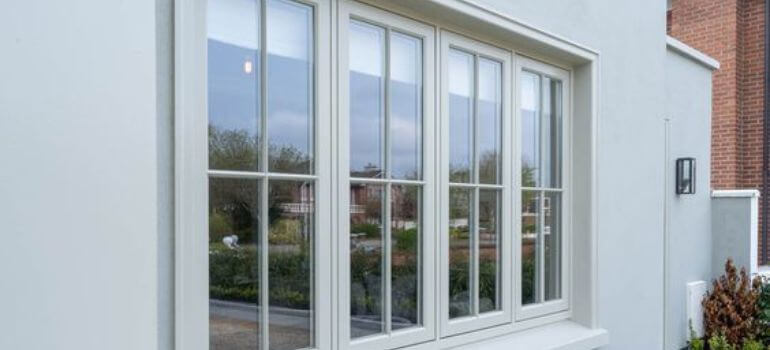When it comes to home improvement projects, upgrading windows is a wise investment. However, homeowners often face a dilemma when choosing between replacement windows and retrofit windows. Both options have their advantages and disadvantages, and deciding which one is right for you depends on several factors.
Key Takeaways:
- The choice between replacement windows and retrofit windows boils down to individual needs and priorities.
- Replacement windows involve completely removing the existing windows and installing new ones, while retrofitting entails upgrading certain window components without replacing them entirely.
- Replacement windows offer more design flexibility and higher energy efficiency, but they are also more expensive and require more labor-intensive installation.
- Retrofit windows are cost-effective and faster to install, but they may compromise aesthetics and energy efficiency.
- A professional assessment of your existing windows can help determine which option is the best fit for your home.
Understanding Replacement Windows
In this section, we will explore the numerous benefits of replacement windows for your home. Not only do they improve energy efficiency and aesthetics, they also increase the overall value of your property. When considering window replacement, it’s important to assess the average cost, as well as the factors to consider when selecting the right window type for your specific needs. Below are some benefits to keep in mind:
- Energy Efficiency: Replacing old windows with new and improved models can reduce energy costs and increase comfort levels in your home.
- Aesthetics: Replacement windows can significantly enhance the look and feel of your home’s interior and exterior.
- Increase Property Value: Upgrading to newer, more energy-efficient windows can increase the overall value of your home.
When replacing windows, it’s important to consider the cost. The average cost of replacement windows varies depending on several factors, such as the size, type of window, and materials used. It’s crucial to weigh the benefits of each option to find the right balance of cost and performance. Some additional factors to consider when choosing replacement windows include:
- Window frame material: The material used in making a window’s frame has a significant impact on its energy efficiency, durability, and maintenance requirements.
- Style: Replacement windows come in different styles that are suited for different purposes. From awning to bay and bow windows, there are numerous designs to choose from.
- Functionality: Each window style has unique features that make it perfect for specific applications. For instance, sliding windows are great for rooms with limited space, while casement windows are ideal for increasing natural light.
Ultimately, replacement windows offer a range of benefits that can enhance the value, attractiveness, and energy efficiency of your home. By understanding the process, benefits, and cost of replacement windows, homeowners can make informed decisions when deciding whether to replace their old windows or not.
Exploring Retrofit Windows

Upgrading your home’s windows with retrofitting can be a cost-effective solution to spruce up your existing windows without entirely replacing them. Retrofit windows have numerous benefits, including enhanced energy efficiency, improved soundproofing, and update the appearance of your home. These windows are typically used when your existing frames are in good condition and only the glass or sash needs replacement.
One significant benefit of retrofit windows is that they provide considerable sound insulation by reducing outside noise, creating a quieter indoor environment. These windows are designed to add an extra layer of insulation, making your home eco-friendly and reducing your energy bills.
The cost of retrofitting windows usually depends on different factors such as the size of the job, the condition of the frames, the type of glass, and the installation process. However, the cost of retrofitting is typically less than the cost of entirely replacing your windows. For instance, retrofitting a standard 36×60 inches window can cost between $200-$400 per window, whereas replacing the same size window would cost between $400-$1000 per window, depending on the materials used.
In conclusion, retrofit windows offer an affordable solution to upgrade and improve your home’s energy efficiency, soundproofing, and appearance. Retrofitted windows allow you to enhance your existing windows rather than replacing them entirely while saving you money. Retrofitting may not be suitable for all windows as some may require a total replacement. Still, it’s worth considering before making your final decision on any window project.
Comparing Replacement Windows vs Retrofit
When deciding between replacement windows and retrofitting your existing windows, it’s essential to understand the key differences between the two options. Here are the factors to consider:
| Replacement Windows | Retrofit Windows | |
|---|---|---|
| Installation Process | Requires the removal of the existing window and installation of a new frame and sash. | Fits new materials onto the existing window frame without removing it, reducing installation time and costs. |
| Impact on Existing Structure | May cause damage to walls and siding during installation. | Less likely to cause structural damage since the existing window frame remains intact. |
| Customization Possibilities | Provides greater flexibility for custom sizes, shapes, and colors. | May have limited customization options due to the existing window frame’s size and shape. |
| Long-term Performance | Offers increased energy efficiency and better performance over time due to modern materials and insulation. | May provide less insulation than replacement windows since the existing window frame is not replaced. |
By comparing the pros and cons of each option, you can make an informed decision when replacing or retrofitting your windows. Regardless of your choice, both options will provide benefits such as improved energy efficiency and increased comfort in your home.
Conclusion
When it comes to deciding between replacement windows and retrofitting, it’s crucial to weigh the pros and cons carefully. Ultimately, the decision will depend on several factors such as budget, existing window condition, energy efficiency goals, and personal preferences.
If budget is a primary concern, retrofitting can be a cost-effective solution, allowing you to upgrade the performance and appearance of your existing windows without entirely replacing them. On the other hand, if you want to enhance energy efficiency, improve aesthetics, and increase the value of your home, replacement windows might be the better choice.
It’s also important to consider the long-term performance and impact on the existing structure when deciding between replacement windows and retrofitting. Replacement windows offer better customization possibilities, and their installation process is less invasive, while the retrofit process can cause damage to some parts of the existing structure.
By carefully considering these factors, you can make an informed decision that best suits your specific needs and requirements. Remember, whether you choose replacement windows or retrofitting, both options can provide significant benefits in terms of energy efficiency and comfort.
So, whether you’re upgrading your home for resale or your own comfort, the choice between replacement windows and retrofitting doesn’t have to be complicated. By understanding the pros and cons of each option, you can make a decision that you’ll be happy with for years to come.
FAQ
What are replacement windows?
Replacement windows refer to the process of completely removing existing windows and installing new ones. This involves replacing the entire window unit including the frame, sashes, and glass. It is a popular choice when homeowners want to upgrade their windows for improved energy efficiency, aesthetics, and functionality.
What are the benefits of replacement windows?
Replacement windows offer several benefits. They can enhance energy efficiency by providing better insulation and reducing air leakage. They also improve the appearance of your home, increase natural light, and reduce noise transmission. Additionally, replacement windows can increase the value of your property and provide a higher return on investment.
How much does it cost to replace windows?
The cost of replacing windows can vary based on factors such as the number of windows, window type, materials, and installation complexity. On average, homeowners can expect to spend between $500 and $1,000 per window, including installation. However, it is recommended to obtain quotes from multiple contractors to get an accurate estimate for your specific project.
What are retrofit windows?
Retrofit windows, also known as window retrofits, involve upgrading existing windows by adding new components without removing the entire window unit. This process typically includes installing new sashes, glass, and weatherstripping. Retrofitting can be a more cost-effective solution compared to replacement, as it utilizes the existing window frame and structure.
What are the benefits of retrofit windows?
Retrofit windows offer several benefits. They can improve energy efficiency by reducing drafts and improving insulation. Retrofitting can also enhance soundproofing by minimizing noise transmission. Additionally, it can provide a fresh appearance to existing windows without the need for extensive construction or replacement.
How much does it cost to retrofit windows?
The cost of retrofitting windows is typically lower compared to full replacement. The cost will depend on factors such as the number of windows, window size, materials used, and any additional enhancements. On average, homeowners can expect to spend between $300 and $700 per window for a retrofit installation. However, it is important to consult with professionals and obtain accurate quotes for your specific project.
Should I choose replacement windows or retrofit?
The choice between replacement windows and retrofitting depends on various factors. If your existing windows are in poor condition or you want to change the style or size significantly, replacement windows may be the better option. Retrofitting is a suitable choice when your existing windows are structurally sound, and you want to enhance their energy efficiency or appearance without a full replacement. It is essential to consider your budget, goals, and the condition of your current windows when making a decision.
What are the main differences between replacement windows and retrofit options?
Replacement windows involve completely removing old windows and installing new ones, while retrofitting upgrades the existing windows by adding new components without removing the entire unit. Replacement windows offer more customization possibilities and can provide a higher level of energy efficiency, but they also tend to be more expensive and require more extensive construction. Retrofitting is often more cost-effective, quicker to install, and can still offer significant energy efficiency improvements.



